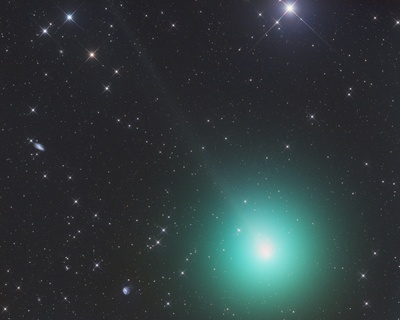A hyperactive comet is approaching Earth
"The comet is currently gliding through the southern constellation Fornax," says Rhemann. "If you look carefully at the image, you can see galaxy NGC 922 near the comet's head, and another galaxy ESO 479-2 on the left."
Rhemann says that the comet's emerald green atmosphere is 50 arcminutes wide. In other words--almost twice as wide as a full Moon. Its apparent diameter could double in the weeks ahead as the comet comes even closer. Because Wirtanen's brightness is spread over such a wide area, it is diluted just below the limit of naked eye visibility, with a current magnitude near +6.0. We don't yet know if the comet will ultimately become visible to the unaided eye--but it will certainly be an easy target for binoculars and backyard telescopes in December.
The nucleus of 46P/Wirtanen is small (~1 km) compared to greater comets such as Hale-Bopp (~30 km) and Halley (~15 km). It makes up for this deficit by hyperactivity. Recent measurements show that the core of 46P/Wirtanen is spinning once every 8.9 hours and spewing almost 1028 water molecules every second. This exceeds the expected production of such a small comet.
Comet Wirtanen passes through the inner solar system every 5.4 years. Right now it is just below the orbit of Earth, and the gap is narrowing.
